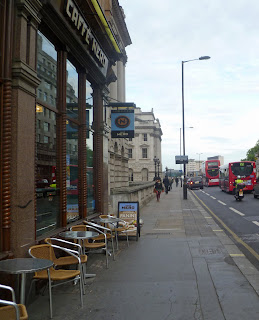Laura Kobak
Labeled as having “US-style cupcakes,” “Hummingbird Bakery” looked promising. With a location on Portobello Road (home to the famous Portobello market), the wait on a Saturday was nearly twenty minutes. With great online reviews, my expectations were high. Unfortunately, with the plain vanilla, I was left disappointed. Neither the cake nor the frosting did it for me. Another bakery off my list was “Violet,” a stall at the Broadway Market in Hackney, which I traveled to with directions in hand. These small cupcakes had the best frosting of all my tastings, but the cake I found dry and lacking in flavor. Additionally, I tried “Lola’s Cupcakes,” “Ella’s Bakehouse,” “Beas of Bloomsbury,” “Crumbs and Dollies,” and “Buttercup Cake Shop” to no avail. (See, I wasn’t kidding about my sweet tooth.) The place that took the cake (pun intended) was “Primrose Bakery.” Not perfect, and not up to the standards of my New York comparisons, but definitely the best of the lot. The cake was moist enough and the frosting was sweet enough, and the rose-flavored cupcake was surprisingly tasteful. Jude Law, Kate Moss, and U2 frequent the bakery’s locations, so at least my taste is agreeable amongst celebrities.
Now, as anyone college-aged and older will agree with me, coffee is a necessity of life. Studying film abroad, many mornings were spent in the dark watching movies. I needed something in hand to help get me through. Exchange rates are never fun, so price was a key factor in my decision-making. Starbucks, of course, was available on several corners, but I vowed to myself that I would not frequent any American chain while abroad. With Starbucks off the list I had to find a viable alternative. The other two main chains available were “Costa Coffee” and “Caffe Nero.” After looking at the prices, there was really no competition: “Caffe Nero” was the winner. With a stamp card for every 9th cup free, I was a relatively frequent customer of this chain. During the winter season I had an amaretto latte, which was to die for. “Monmouth Coffee Company” made a deliciously creamy latte as well, but with a hefty price tag and no “skinny” option, a visit there was more of a treat.
So, if you ever visit London and need a pick-me-up or a sweet treat, you know where to go!
Fun Fact: The British version of a cupcake is called a “fairy cake”. (It sounds much more enchanting than plain old “cupcake” if you ask me.) Also, a “tall” at Starbucks in America is equal to a medium-sized drink in Europe.
Updated 11/19/2011 4:45pm





